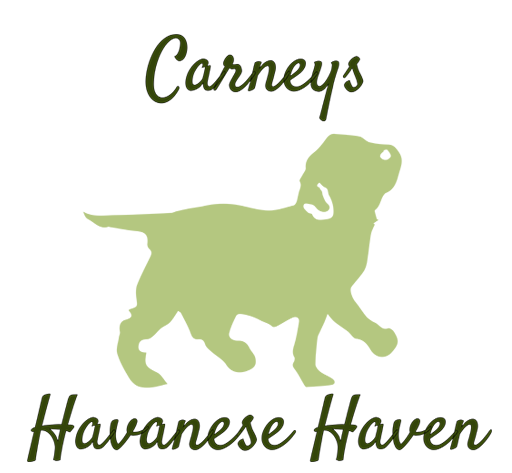 |
| Meet Oreo, a little girl |
One of my families asked what they should have on hand for their new puppy so I thought I’d post my list. Also a few photos with names and genders. Hoping to take a video outside as we finally have some warm weather again!
1. Carrier (to bring your puppy home) If you plan to travel on an airplane with your puppy it is wise to purchase a sturdy, soft sided carrier that is airplane approved and that will fit under the seat. Get one that will accommodate your puppy when it is full-grown too. (About 12-14 pounds) Plan so spend about $30-$60.
 |
| This is Hershey. a little boy with sable and white coloring. |
2. Harness and leash. Because a Havanese puppy is so small, I don’t recommend collars. The size harness you will want will be extra small (up to 4 pound pup) or small (4-8 pound pup).
3. Crate. I recommend the open wire crates with a removable floor (for cleaning) and a divider that will create a smaller space for sleeping until the pup is completely housebroken. A crate appropriate for a 15 pound dog is more than sufficient. Any larger gives the pup too much space inside.
4. Exercise Pen (X-pen) The 8 panel, 30” tall, pen is fine. Some come with gates, some do not. Plan to spend about $40.
5. Food bowls. Ceramic or stainless steel are best. Puppies will chew plastic ones. Smaller is good (5” max) as the older pup’s ears will likely land outside the bowl (and the food).
 |
| This is Twix, a little girl |
6. Food. Your puppy has been eating Wellness Super Mix Just for Puppy (available at most pet stores). They are used to three meals a day…about ¼ cup per meal.
7. Toys. Puppies love toys! Lots of toys keep their interest away from furniture, cords and shoes! Tough rubber toys for teething are good, especially the small “Kong” toys you can stuff with yogurt and freeze. Squeaky toys are good too. Just don’t spend a lot on these squeaky toys as they pup will likely dismember it in a few weeks!
8. Piddle Pads. Your puppy is trained to use a piddle pad. I use the pale blue, plastic backed ones with 4 layers of newspaper on top. This seems to reduce the shredding motivation. As the pup matures you can eliminate the newspaper.
9. Piddle Pad Frame. You will also need the plastic piddle pad frame to hold the pads in place. I was lucky enough to find the adhesive backed pads at one point, which eliminated the need for the frame. I have not been able to find them lately though.If you plan to keep your piddle pad as a permanent place for pottying you can buy them online a lot cheaper…100 for $50.
 |
| Meet Hershey, a little boy. |
10. Nail Clippers and Brush. Your puppy is used to having his nails trimmed. I do this to reduce their angst down the road. You can use a human nail clipper for now…the kind that clip from the side are good. Later you will need a regular dog nail trimmer. The mini slicker brush work best for general grooming. Again, he is used to this and it is a good idea to continue to brush him 2-3 times a week just for a few minutes.
11. 5-6” long Nylabones. Do not use rawhide chews for puppies and always supervise your puppy when he is chewing any kind of bones.
12. Natures Miracle spray. There are all kinds of sizes as well as special formulas for hardwood floors, laundry, etc. The best produce I’ve found for removing odors and stains.
13. Bathing supplies should include shampoo, conditioner and detangler. For the first two, I actually use Tresemee’ brand that you can find in most grocery and drug stores. For the detangler I use Christensen’s Ice on Ice Detangler which can be purchased online.You dilute this and leave it on the puppy’s coat after he’s been shampooed and conditioned.
 |
| Twix again. |
 |
| Twix is a little hesitant about joining her siblings. |
 |
| Oreo |
 |
| Taffy, a boy, is the largest pup (for now!). He has darling brown eyebrows. |
 |
| Taffy (left), Snickers (top) and Twix (right) |
 |
| Twizzler, a little girl, loves to play with my toes. |
 |
| I love Twizzler’s head |
 |
| Snickers on a march! |

















































